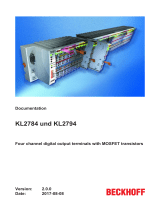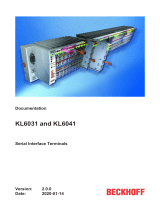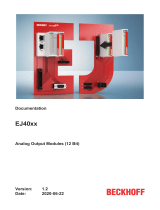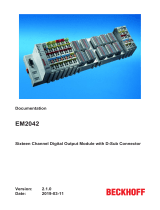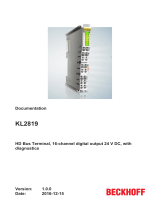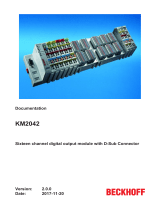Page is loading ...

Documentation
KL9020, KL9050
K-Bus Extension
2.1.0
2019-10-07
Version:
Date:


Table of contents
KL9020, KL9050 3Version: 2.1.0
Table of contents
1 Foreword ....................................................................................................................................................5
1.1 Notes on the documentation..............................................................................................................5
1.2 Safety instructions .............................................................................................................................6
1.3 Documentation Issue Status..............................................................................................................7
1.4 Beckhoff Identification Code (BIC) ....................................................................................................8
2 Product Overview ....................................................................................................................................10
2.1 Functional description......................................................................................................................10
2.2 KL9020: End Terminal with RJ45 socket.........................................................................................11
2.3 KL9050: Coupler Terminal...............................................................................................................12
2.4 Technical Data.................................................................................................................................13
3 Fitting and wiring.....................................................................................................................................14
3.1 Instructions for ESD protection........................................................................................................14
3.2 Structure of a K-bus extension ........................................................................................................14
3.3 Installation on mounting rails ...........................................................................................................17
3.4 Connection ......................................................................................................................................19
3.4.1 Connection system .......................................................................................................... 19
3.4.2 Wiring............................................................................................................................... 21
3.5 Power supply ...................................................................................................................................22
3.6 ATEX - Special conditions (standard temperature range) ...............................................................24
3.7 ATEX Documentation ......................................................................................................................25
4 Diagnostics ..............................................................................................................................................26
4.1 Diagnostic LEDs ..............................................................................................................................26
4.2 Fault table for K-Bus interruption.....................................................................................................28
5 Appendix ..................................................................................................................................................29
5.1 Ordering information........................................................................................................................29
5.2 Support and Service ........................................................................................................................30

Table of contents
KL9020, KL90504 Version: 2.1.0

Foreword
KL9020, KL9050 5Version: 2.1.0
1 Foreword
1.1 Notes on the documentation
Intended audience
This description is only intended for the use of trained specialists in control and automation engineering who
are familiar with the applicable national standards.
It is essential that the documentation and the following notes and explanations are followed when installing
and commissioning these components.
It is the duty of the technical personnel to use the documentation published at the respective time of each
installation and commissioning.
The responsible staff must ensure that the application or use of the products described satisfy all the
requirements for safety, including all the relevant laws, regulations, guidelines and standards.
Disclaimer
The documentation has been prepared with care. The products described are, however, constantly under
development.
We reserve the right to revise and change the documentation at any time and without prior announcement.
No claims for the modification of products that have already been supplied may be made on the basis of the
data, diagrams and descriptions in this documentation.
Trademarks
Beckhoff
®
, TwinCAT
®
, EtherCAT
®
, EtherCATG
®
, EtherCATG10
®
, EtherCATP
®
, SafetyoverEtherCAT
®
,
TwinSAFE
®
, XFC
®
, XTS
®
and XPlanar
®
are registered trademarks of and licensed by Beckhoff Automation
GmbH. Other designations used in this publication may be trademarks whose use by third parties for their
own purposes could violate the rights of the owners.
Patent Pending
The EtherCAT Technology is covered, including but not limited to the following patent applications and
patents: EP1590927, EP1789857, EP1456722, EP2137893, DE102015105702 with corresponding
applications or registrations in various other countries.
EtherCAT
®
is registered trademark and patented technology, licensed by Beckhoff Automation GmbH,
Germany.
Copyright
© Beckhoff Automation GmbH & Co. KG, Germany.
The reproduction, distribution and utilization of this document as well as the communication of its contents to
others without express authorization are prohibited.
Offenders will be held liable for the payment of damages. All rights reserved in the event of the grant of a
patent, utility model or design.

Foreword
KL9020, KL90506 Version: 2.1.0
1.2 Safety instructions
Safety regulations
Please note the following safety instructions and explanations!
Product-specific safety instructions can be found on following pages or in the areas mounting, wiring,
commissioning etc.
Exclusion of liability
All the components are supplied in particular hardware and software configurations appropriate for the
application. Modifications to hardware or software configurations other than those described in the
documentation are not permitted, and nullify the liability of Beckhoff Automation GmbH & Co. KG.
Personnel qualification
This description is only intended for trained specialists in control, automation and drive engineering who are
familiar with the applicable national standards.
Description of instructions
In this documentation the following instructions are used.
These instructions must be read carefully and followed without fail!
DANGER
Serious risk of injury!
Failure to follow this safety instruction directly endangers the life and health of persons.
WARNING
Risk of injury!
Failure to follow this safety instruction endangers the life and health of persons.
CAUTION
Personal injuries!
Failure to follow this safety instruction can lead to injuries to persons.
NOTE
Damage to environment/equipment or data loss
Failure to follow this instruction can lead to environmental damage, equipment damage or data loss.
Tip or pointer
This symbol indicates information that contributes to better understanding.

Foreword
KL9020, KL9050 7Version: 2.1.0
1.3 Documentation Issue Status
Version Comment
2.1.0 • Update chapter “Instructions for ESD protection”
• Chapter Beckhoff Identification Code (BIC)” added
• Update Firmware and hardware versions
2.0.0 • Migration
• Update Technical data
• Chapter Instructions for ESD protection added
• Update chapter Connection added
• Chapters ATEX - special conditions (standard temperature range) and ATEX
documentation added
• Firmware and hardware versions updated
• Structure update
1.2.0 • Description of the structure of a K-bus extension expanded
• Mounting description expanded
1.1.1 • Foreword and appendix updated
• Product overview for KL9050 updated
1.1 • Ordering information updated
• Description of the diagnostic LEDs corrected
1.0 First release
Firmware and hardware versions
Documentation
Version
KL9020 KL9050
Firmware Hardware Firmware Hardware
2.1.0 03 13 01 07
2.0.0 03 12 01 06
1.2.0 03 08 01 03
1.1.1 03 07 01 02
1.1 01 02 01 01
1.0 01 02 01 01
The firmware and hardware versions (delivery state) can be found in the serial number printed on the side of
the terminal.
Syntax of the serial number
Structure of the serial number: KKYYFFHH
KK - week of production (CW, calendar week)
YY - year of production
FF - firmware version
HH - hardware version
Example with ser. No.: 35 05 03 07:
35 - week of production 35
05 - year of production 2005
03 - firmware version 03
07 - hardware version 07

Foreword
KL9020, KL90508 Version: 2.1.0
1.4 Beckhoff Identification Code (BIC)
The Beckhoff Identification Code (BIC) is increasingly being applied to Beckhoff products to uniquely identify
the product. The BIC is represented as a Data Matrix Code (DMC, code scheme ECC200), the content is
based on the ANSI standard MH10.8.2-2016.
Fig.1: BIC as data matrix code (DMC, code scheme ECC200)
The BIC will be introduced step by step across all product groups.
Depending on the product, it can be found in the following places:
• on the packaging unit
• directly on the product (if space suffices)
• on the packaging unit and the product
The BIC is machine-readable and contains information that can also be used by the customer for handling
and product management.
Each piece of information can be uniquely identified using the so-called data identifier
(ANSIMH10.8.2-2016). The data identifier is followed by a character string. Both together have a maximum
length according to the table below. If the information is shorter, spaces are added to it. The data under
positions 1 to 4 are always available.
The following information is contained:

Foreword
KL9020, KL9050 9Version: 2.1.0
Item
no.
Type of
information
Explanation Data
identifier
Number of digits
incl. data identifier
Example
1 Beckhoff order
number
Beckhoff order number 1P 8 1P072222
2 Beckhoff Traceability
Number (BTN)
Unique serial number,
see note below
S 12 SBTNk4p562d7
3 Article description Beckhoff article
description, e.g.
EL1008
1K 32 1KEL1809
4 Quantity Quantity in packaging
unit, e.g. 1, 10, etc.
Q 6 Q1
5 Batch number Optional: Year and week
of production
2P 14 2P401503180016
6 ID/serial number Optional: Present-day
serial number system,
e.g. with safety products
51S 12 51S678294104
7 Variant number Optional: Product variant
number on the basis of
standard products
30P 32 30PF971, 2*K183
...
Further types of information and data identifiers are used by Beckhoff and serve internal processes.
Structure of the BIC
Example of composite information from item 1 to 4 and 6. The data identifiers are marked in red for better
display:
BTN
An important component of the BIC is the Beckhoff Traceability Number (BTN, item no.2). The BTN is a
unique serial number consisting of eight characters that will replace all other serial number systems at
Beckhoff in the long term (e.g. batch designations on IO components, previous serial number range for
safety products, etc.). The BTN will also be introduced step by step, so it may happen that the BTN is not yet
coded in the BIC.
NOTE
This information has been carefully prepared. However, the procedure described is constantly being further
developed. We reserve the right to revise and change procedures and documentation at any time and with-
out prior notice. No claims for changes can be made from the information, illustrations and descriptions in
this information.

Product Overview
KL9020, KL905010 Version: 2.1.0
2 Product Overview
2.1 Functional description
System expansion
Based on a bus terminal block consisting of a Bus Coupler and a maximum of 64 Bus Terminals, using the
K-bus Extension Terminals KL9020 and KL9050 your system can be expanded by up to 31 terminal blocks.
The expansion terminal blocks can be equipped with a maximum of 64 Bus Terminals each. The maximum
permissible configuration consists of 255 Bus Terminals and 1020 I/Os. The K-bus Extension Terminals
KL9020 and KL9050 enable a distance of 5m max. between two terminal blocks and therefore an overall
system length of 155m.
Fig.2: KL9020 and KL9050 in the Beckhoff Bus Terminal system
The K-bus Extension Terminals KL9020 and KL9050 integrate seamlessly into the Beckhoff Bus Terminal
system in terms of their appearance and functionality. The transparent terminal lugs used for labelling
indicate their function as system terminals.
KL9020
The End Terminal with RJ45 socket (KL9020 [}11]) is plugged into the end of the bus terminal block
instead of a standard End Terminal (KL9010) and enables the connection of the K-bus extension cable. The
electronics of the KL9020 are supplied via the K-bus from the Fieldbus Coupler.
KL9050
In the expansion terminal blocks, the Coupler Terminal KL9050 [}12] replaces the Fieldbus Coupler and
takes over its function. It is mounted on the mounting rail [}17] at the start of the extension station and
connected to the preceding Bus Terminal block via an RJ45 socket with the designation IN by means of a K-
bus extension cable with a maximum length of 5m. Connect the K-bus extension cable
• of the first expansion terminal block to the End Terminal with RJ45 socket (KL9020) of the terminal
block with the Fieldbus Coupler.

Product Overview
KL9020, KL9050 11Version: 2.1.0
• of all other expansion terminal blocks with the RJ45 socket (identified with OUT) of the Coupler
Terminal (KL9050) of the preceding expansion terminal block.
The power contacts and the corresponding connection points of the Coupler Terminal are electrically isolated
from the K-bus.
K-bus extension cable
The data is transmitted between the terminal blocks via eight-core Ethernet cables with RJ45 plugs. Beckhoff
offers pre-assembled cables in different lengths, which can be customized with commercially available
Ethernet tools.
The K-bus Extension Terminals should also work with cables from other manufacturers. However,
Beckhoff recommends the use of Beckhoff Ethernet cables [}29], which are tested for the specified
functionality.
2.2 KL9020: End Terminal with RJ45 socket
Fig.3: KL9020
Interface Function
K-Bus extension output RJ45 socket for the continuing K-bus extension

Product Overview
KL9020, KL905012 Version: 2.1.0
2.3 KL9050: Coupler Terminal
Fig.4: KL9050
LED No. Function
Power V
k
, green A LED indicates whether the supply voltage for the electronics of the Coupler Terminal is switched on.
Power, green C LED indicates whether the supply voltage for the I/O terminals of the terminal block is switched on. The
power supply of the terminals is via the power contacts.
RUN (K-Bus IN), green - LED indicates that data is being transmitted on the K-bus.
ERR (K-Bus IN), red - LED indicating a fault on the K-Bus.
Terminal point No. Function
V
k
24V 1 Input of the +24V supply voltage for the Coupler Terminal electronics
+24V 2 Input of the +24V supply voltage for the power contacts (internally connected to terminal point 6)
0 V 3 Input of the 0V supply voltage for the power contacts (internally connected to terminal point 7)
PE 4 PE connection (internally connected to terminal point 8)
V
k
0V 5 Input of the 0V supply voltage for the Coupler Terminal electronics
+24V 6 Input of the +24V supply voltage for the power contacts (internally connected to terminal point 2)
0 V 7 Input of the 0V supply voltage for the power contacts (internally connected to terminal point 3)
PE 8 PE connection (internally connected to terminal point 4)
Interface Function
K-bus In RJ45 socket for the incoming K-bus extension
K-bus OUT RJ45 socket for the continuing K-bus extension
K-bus Internal K-bus of the Bus Terminal block
Power Contacts Internal power contacts of a bus terminal block
Function Switch [}16]
Switch for the termination resistor of the Coupler Terminal

Product Overview
KL9020, KL9050 13Version: 2.1.0
2.4 Technical Data
Technical Data General
Number of Bus Terminals per Fieldbus Coupler with BKxx20 or BKxx50 fieldbus coupler: max. 255
with Fieldbus Couplers BKxx00 or BKxx10: max. 64
Number of bytes per Fieldbus Coupler limited by Fieldbus Coupler and Fieldbus Limit (see documentation for the Field-
bus Coupler being used)
Increase in runtime due to K-bus extension negligible (see runtime calculation in the documentation for the Fieldbus Coupler
used)
Length of cable between 2 terminal blocks max. 5m
Total length of cable (from KL9020 to the last
KL9050)
max. 155m (31 x 5 m)
Topology Bus structure
Technical Data
KL9020 [
}
11] End Terminal with RJ45 socket for K-Bus extension
Fieldbus independent
Number of KL9020 per Fieldbus Coupler 1
Configuration automatic
Current consumption from the K-bus typically 70mA
Dielectric strength 500V (shielding, base plate / K-bus)
Permissible ambient temperature range during oper-
ation
0°C ... + 55°C
Permissible ambient temperature range during stor-
age
-25°C ... + 85°C
Permissible relative air humidity 95%, no condensation
Vibration/shock resistance conforms to EN60068-2-6/ EN60068-2-27
EMC immunity/emission conforms to EN61000-6-2 / EN61000-6-4
Weight approx. 45g
Dimensions (W x H x D) approx. 26mmx100mmx70mm
Mounting [}15]
on 35mm mounting rail conforms to EN60715
Installation position variable
Protection class IP20
Approvals
CE, UL, ATEX [}24], GL see Beckhoff Homepage
Technical Data
KL9050 [
}
12] K-Bus Extension Coupler Terminal
Number of Bus Terminals per KL9050 max. 64
Number of KL9050 per Fieldbus Coupler max. 31
Configuration
via switch Function switch [}16]
Supply voltage 24V
DC
(-15%/+20%)
Current consumption (via Terminals V
k
24V, V
k
0V) maximum 200mA
Calculation: 70mA + (K-bus current of the terminal block)/4
Starting current 2.5 x nominal current
K-bus power supply (for Bus Terminals) maximum 400mA
Power contacts voltage maximum 30V
DC
Power contact current load 10A max. (short-circuit 125A)
Dielectric strength 500V (power contact/supply voltage/fieldbus)
Permissible ambient temperature range during oper-
ation
0°C ... + 55°C
Permissible ambient temperature range during stor-
age
-25°C ... + 85°C
Permissible relative air humidity 95%, no condensation
Vibration / shock resistance conforms to EN60068-2-6 / EN60068-2-27
EMC immunity/emission conforms to EN61000-6-2 / EN61000-6-4
Weight approx. 75g
Dimensions (W x H x D) approx. 24.5mmx100mmx70mm
Mounting [}15]
on 35mm mounting rail conforms to EN60715
Installation position variable
Protection class IP20
Approvals
CE, UL, ATEX [}24], GL see Beckhoff Homepage

Fitting and wiring
KL9020, KL905014 Version: 2.1.0
3 Fitting and wiring
3.1 Instructions for ESD protection
NOTE
Destruction of the devices by electrostatic discharge possible!
The devices contain components at risk from electrostatic discharge caused by improper handling.
• Please ensure you are electrostatically discharged and avoid touching the contacts of the device directly.
• Avoid contact with highly insulating materials (synthetic fibers, plastic film etc.).
• Surroundings (working place, packaging and personnel) should by grounded probably, when handling
with the devices.
• Each assembly must be terminated at the right hand end with a KL9010 bus end terminal, to ensure the
protection class and ESD protection.
Fig.5: Spring contacts of the Beckhoff I/O components
3.2 Structure of a K-bus extension
DANGER
Risk of injury through electric shock and damage to the device!
Bring the Bus Terminals system into a safe, de-energized state before starting mounting, disassembly or
wiring of the Bus Terminals!

Fitting and wiring
KL9020, KL9050 15Version: 2.1.0
Fig.6: KL9020 and KL9050 in the Beckhoff Bus Terminal system
Mounting
When mounting, observe the information in the chapter entitled Mounting rail installation [}17].
1. Ensure that the system is powered down and in a safe state.
2. Install the first bus terminal block, consisting of the fieldbus coupler and the desired Bus Terminals, on
a mounting rail.
Instead of a standard End Terminal (KL9010), install an End Terminal with RJ45 socket (KL9020) as
the last terminal at the end of the first Bus Terminal block.
3. Install the first expansion terminal block, consisting of a Coupler Terminal (KL9050) and the desired
Bus Terminals, on a mounting rail [}13].
Install a standard End Terminal (KL9010) as the last terminal at the end of the first expansion terminal
block.
4. Connect one RJ45 plug of an Ethernet cable into the RJ45 socket of the KL9020 of the first bus termi-
nal block until it clicks into place.
Connect the other RJ45 plug of the Ethernet cable into the RJ45 socket (labelled IN) of the expansion
terminal block Coupler Terminal (KL9050) until it clicks into place.
5. Install the next expansion terminal block, consisting of a Coupler Terminal (KL9050) and the desired
Bus Terminals, on a mounting rail [}13].
Install a standard End Terminal (KL9010) as the last terminal at the end of this expansion terminal
block.
6. Connect one RJ45 plug of an Ethernet cable into the RJ45 socket (labelled OUT) of the KL9020 of the
previous expansion terminal block until it clicks into place.
Connect the other RJ45 plug of the Ethernet cable into the RJ45 socket (labelled IN) of the KL9050 of
the added expansion terminal block until it clicks into place.
7. Repeat steps 5 and 6 in order to connect further expansion terminal blocks. A maximum of 31 expan-
sion terminal blocks can be connected.
8. Set the Function Switch [}16] on all Coupler Terminals (KL9050) correctly.

Fitting and wiring
KL9020, KL905016 Version: 2.1.0
Function Switch
Fig.7: KL9050 - Function Switch
• Switch position Next:
The Function Switch of all Coupler Terminals (KL9050) to which a continuing Ethernet cable is
connected must be set to position Next!
• Switch position Last:
Activate the terminating resistor at the last expansion terminal block of your K-bus extension system by
switching the Function Switch on the last Coupler Terminal (KL9050) to the Last position.
CAUTION
Danger to persons, the environment and equipment
ü Correct setting of the Function Switches of all Coupler Terminals (KL9050) within a K-bus extension
system must be ensured!
ü Correct setting of the Function Switches must also be ensured if Coupler Terminals (KL9050) are re-
placed!
ü Please note that all extension terminal blocks connected after a Coupler Terminal (KL9050), whose
Function Switch is set to the Last position, are not included correctly in the process image! This means:
a) The inputs of these terminals are not visible in the process image!
b) The outputs of these terminals are not controlled by the process image!
ð The Function Switch may be set to the Last position only at the last Coupler Terminal (KL9050) of the
K-bus extension system!
Notes on the topology
Notes on the connection of the KL9020 and KL9050 terminals
The end terminal with RJ45 socket (KL9020) may only be used at the end of Bus Terminal blocks
that are opened by a fieldbus coupler! All extension terminal blocks must be terminated by a
KL9010 standard end terminal!
At least one terminal with process image must be connected to each KL9050 Coupler Terminal! The
operation of an extension terminal block with only one KL9010 (with no inputs or outputs) is not per-
missible
Disassembly
When mounting, observe the information in the chapter entitled Mounting rail installation [}17].
1. Ensure that the system is powered down and in a safe state.
2. Press the plastic lock of the RJ45 plug and pull it from the socket.
3. Carefully pull the orange-colored lug approximately 1cm out of the terminal to be disassembled, until
it protrudes loosely. The lock with the C mounting rail is now released for this terminal, and the termi-
nal can be pulled from the mounting rail without excessive force.
4. Grasp the released terminal with thumb and index finger simultaneous at the upper and lower grooved
housing surfaces and pull the terminal away from the mounting rail.

Fitting and wiring
KL9020, KL9050 17Version: 2.1.0
3.3 Installation on mounting rails
WARNING
Risk of electric shock and damage of device!
Bring the bus terminal system into a safe, powered down state before starting installation, disassembly or
wiring of the bus terminals!
Assembly
Fig.8: Attaching on mounting rail
The bus coupler and bus terminals are attached to commercially available 35mm mounting rails (DIN rails
according to EN60715) by applying slight pressure:
1. First attach the fieldbus coupler to the mounting rail.
2. The bus terminals are now attached on the right-hand side of the fieldbus coupler. Join the compo-
nents with tongue and groove and push the terminals against the mounting rail, until the lock clicks
onto the mounting rail.
If the terminals are clipped onto the mounting rail first and then pushed together without tongue and
groove, the connection will not be operational! When correctly assembled, no significant gap should
be visible between the housings.
Fixing of mounting rails
The locking mechanism of the terminals and couplers extends to the profile of the mounting rail. At
the installation, the locking mechanism of the components must not come into conflict with the fixing
bolts of the mounting rail. To mount the mounting rails with a height of 7.5mm under the terminals
and couplers, you should use flat mounting connections (e.g. countersunk screws or blind rivets).

Fitting and wiring
KL9020, KL905018 Version: 2.1.0
Disassembly
Fig.9: Disassembling of terminal
Each terminal is secured by a lock on the mounting rail, which must be released for disassembly:
1. Pull the terminal by its orange-colored lugs approximately 1cm away from the mounting rail. In doing
so for this terminal the mounting rail lock is released automatically and you can pull the terminal out of
the bus terminal block easily without excessive force.
2. Grasp the released terminal with thumb and index finger simultaneous at the upper and lower grooved
housing surfaces and pull the terminal out of the bus terminal block.
Connections within a bus terminal block
The electric connections between the Bus Coupler and the Bus Terminals are automatically realized by
joining the components:
• The six spring contacts of the K-Bus/E-Bus deal with the transfer of the data and the supply of the Bus
Terminal electronics.
• The power contacts deal with the supply for the field electronics and thus represent a supply rail within
the bus terminal block. The power contacts are supplied via terminals on the Bus Coupler (up to 24V)
or for higher voltages via power feed terminals.
Power Contacts
During the design of a bus terminal block, the pin assignment of the individual Bus Terminals must
be taken account of, since some types (e.g. analog Bus Terminals or digital 4-channel Bus Termi-
nals) do not or not fully loop through the power contacts. Power Feed Terminals (KL91xx, KL92xx
or EL91xx, EL92xx) interrupt the power contacts and thus represent the start of a new supply rail.
PE power contact
The power contact labeled PE can be used as a protective earth. For safety reasons this contact mates first
when plugging together, and can ground short-circuit currents of up to 125A.

Fitting and wiring
KL9020, KL9050 19Version: 2.1.0
Fig.10: Power contact on left side
NOTE
Possible damage of the device
Note that, for reasons of electromagnetic compatibility, the PE contacts are capacitatively coupled to the
mounting rail. This may lead to incorrect results during insulation testing or to damage on the terminal (e.g.
disruptive discharge to the PE line during insulation testing of a consumer with a nominal voltage of 230V).
For insulation testing, disconnect the PE supply line at the Bus Coupler or the Power Feed Terminal! In or-
der to decouple further feed points for testing, these Power Feed Terminals can be released and pulled at
least 10mm from the group of terminals.
WARNING
Risk of electric shock!
The PE power contact must not be used for other potentials!
3.4 Connection
3.4.1 Connection system
WARNING
Risk of electric shock and damage of device!
Bring the bus terminal system into a safe, powered down state before starting installation, disassembly or
wiring of the bus terminals!
Overview
The Bus Terminal system offers different connection options for optimum adaptation to the respective
application:
• The terminals of ELxxxx and KLxxxx series with standard wiring include electronics and connection
level in a single enclosure.
• The terminals of ESxxxx and KSxxxx series feature a pluggable connection level and enable steady
wiring while replacing.
• The High Density Terminals (HD Terminals) include electronics and connection level in a single
enclosure and have advanced packaging density.

Fitting and wiring
KL9020, KL905020 Version: 2.1.0
Standard wiring (ELxxxx / KLxxxx)
Fig.11: Standard wiring
The terminals of ELxxxx and KLxxxx series have been tried and tested for years.
They feature integrated screwless spring force technology for fast and simple assembly.
Pluggable wiring (ESxxxx / KSxxxx)
Fig.12: Pluggable wiring
The terminals of ESxxxx and KSxxxx series feature a pluggable connection level.
The assembly and wiring procedure is the same as for the ELxxxx and KLxxxx series.
The pluggable connection level enables the complete wiring to be removed as a plug connector from the top
of the housing for servicing.
The lower section can be removed from the terminal block by pulling the unlocking tab.
Insert the new component and plug in the connector with the wiring. This reduces the installation time and
eliminates the risk of wires being mixed up.
The familiar dimensions of the terminal only had to be changed slightly. The new connector adds about 3
mm. The maximum height of the terminal remains unchanged.
A tab for strain relief of the cable simplifies assembly in many applications and prevents tangling of individual
connection wires when the connector is removed.
Conductor cross sections between 0.08mm
2
and 2.5mm
2
can continue to be used with the proven spring
force technology.
The overview and nomenclature of the product names for ESxxxx and KSxxxx series has been retained as
known from ELxxxx and KLxxxx series.
High Density Terminals (HD Terminals)
Fig.13: High Density Terminals
The Bus Terminals from these series with 16 terminal points are distinguished by a particularly compact
design, as the packaging density is twice as large as that of the standard 12mm Bus Terminals. Massive
conductors and conductors with a wire end sleeve can be inserted directly into the spring loaded terminal
point without tools.
/
